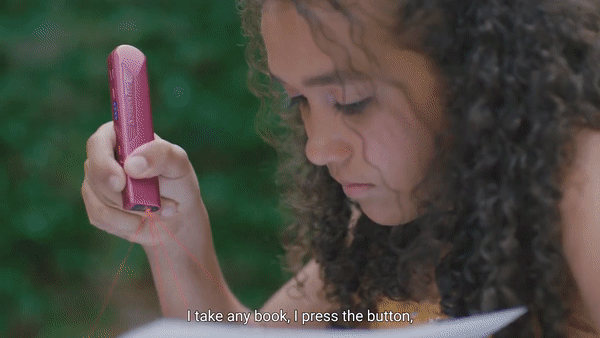Revolutionizing Teaching and Learning: A Pathway to Student Success and Inclusivity
2023-05-15 | By Orcam Staff
.png)
Educational technology, also known as EdTech, has revolutionized the way we approach teaching and learning. In today's digital age, the integration of technology in education has become essential for fostering engaging and effective learning experiences. This article aims to provide a comprehensive understanding of the benefits and uses of educational technology, with a particular focus on technology in the classroom and assistive technology for dyslexia.
In recent years, the rapid advancements in technology have paved the way for innovative teaching methods and tools that enhance educational outcomes. From interactive whiteboards to educational apps and virtual classrooms, technology has become an indispensable asset in modern-day education. Its significance extends beyond the classroom walls, enabling learners of all ages to access a wealth of knowledge and resources with just a few clicks.
The benefits of technology in education are vast and impactful. By incorporating technology into the learning process, educators can create dynamic and immersive environments that captivate students' attention and foster active participation. Technology offers personalized learning experiences, catering to diverse learning styles and abilities, empowering students to take ownership of their education.
Moreover, the impact of educational technology reaches beyond traditional academic subjects. It equips students with digital literacy skills, preparing them for the demands of the 21st-century workforce. Technology also promotes collaboration and communication, enabling students to connect and engage with peers and experts from around the world, transcending geographical boundaries.
Throughout this article, we will explore the multifaceted advantages of technology in education, delve into the specific applications of technology in the classroom, and shed light on the transformative potential of assistive technology for dyslexic students. By harnessing the power of technology, educators can unlock new opportunities for enhanced learning and empower students to thrive in a rapidly evolving digital landscape.
Technology in the Classroom
Technology has revolutionized the classroom environment, opening up new avenues for learning and transforming the way educators teach and students engage with content. By integrating technology into the classroom, educators can enhance the learning experience, promote active participation, and equip students with valuable skills for the digital age. This section explores the advantages of integrating technology in the classroom, provides examples of commonly used technologies, and highlights success stories and case studies that demonstrate the positive impact of technology integration.
Advantages of Integrating Technology in the Classroom
Engaging Learning:
- Technology creates an interactive learning environment that captivates students' attention and fosters active participation.
- Gamification elements, such as educational games and quizzes, make the learning process enjoyable and engaging.
- Multimedia content, such as videos and interactive presentations, stimulates students' interest and facilitates better understanding of complex concepts.
- Collaborative online platforms and tools encourage teamwork and peer interaction, promoting engagement and knowledge sharing.
Enhanced Collaborative Learning Opportunities:
- Technology enables collaboration through virtual classrooms, online discussion boards, and group projects.
- Students can work together on shared documents, provide real-time feedback, and engage in collaborative problem-solving.
Access to a Vast Range of Educational Resources:
- The internet offers a wealth of educational resources, including online libraries, research databases, and educational websites.
- Students can explore diverse perspectives, access up-to-date information, and engage in self-directed learning.
Examples of Technology Used in the Classroom
Interactive Whiteboards and Smart Projectors:
Interactive whiteboards allow teachers to present dynamic lessons, annotate content, and engage students in hands-on activities.
Smart projectors display interactive content on any surface, turning classrooms into immersive learning environments.
Tablets and Laptops for Personalized Learning:
Tablets and laptops provide portable devices for students to access digital textbooks, multimedia content, and educational apps.
Personalized learning software tailors educational content to students' abilities and tracks their progress.
Educational Apps and Software:
Educational apps offer interactive learning experiences, covering various subjects and skills.
Learning management systems streamline classroom administration, grading, and communication between teachers, students, and parents.
.png)
Success Stories and Case Studies Showcasing Technology Integration in Classrooms
Case Study: XYZ Primary School's Digital Transformation:
XYZ Primary School implemented a 1:1 device program, equipping students with tablets.
The program resulted in improved student engagement, collaborative projects, and personalized learning experiences.
Success Story: Using Virtual Reality in Science Education:
A science teacher incorporated virtual reality (VR) simulations into their lessons.
Students immersed themselves in virtual environments, deepening their understanding of complex scientific concepts.
Case Study: Technology-Enhanced Flipped Learning Approach:
ABC High School adopted a flipped learning model using educational videos and online discussion forums.
Students accessed instructional videos at home, allowing more interactive and collaborative class time.
These success stories and case studies demonstrate the positive impact of technology integration in classrooms, highlighting how it enhances student engagement, collaboration, and learning outcomes. By embracing technology, educators can create dynamic learning environments that prepare students for the challenges of the digital era.
Assistive Technology for Dyslexia
Assistive technology plays a vital role in supporting students with dyslexia, a learning difference that affects reading, writing, and spelling abilities. This section provides an understanding of dyslexia and its challenges, an overview of assistive technology specifically designed for dyslexic students, and highlights the benefits and success stories associated with the use of assistive technology.
Explanation of Dyslexia and its Challenges
Dyslexia is a neurodevelopmental condition that affects the way individuals process language, particularly in relation to reading and writing. Dyslexic students may struggle with phonological processing, decoding words, and comprehending written text. These challenges can impact their academic performance and overall confidence in the classroom.
Overview of Assistive Technology for Dyslexic Students
Text-to-Speech Software and Devices:
Text-to-speech software converts written text into spoken words, allowing dyslexic students to listen to the content instead of reading it.
Dedicated devices or computer applications can read aloud digital documents, textbooks, and webpages, enhancing comprehension and reducing reading difficulties.
Dyslexia-Friendly Fonts and Reading Aids:
Dyslexia-friendly fonts, such as OpenDyslexic and Dyslexie, feature unique characteristics that make reading easier for dyslexic individuals.
Reading aids, such as colored overlays or reading rulers, can reduce visual stress and improve focus on written text.
Spelling and Grammar Checking Tools:
Spelling and grammar checking software assist dyslexic students in identifying and correcting errors in their written work.
These tools provide real-time feedback, helping students improve their writing skills and enhance their confidence.
Benefits and Success Stories of Assistive Technology for Dyslexia
The use of assistive technology has shown significant benefits for dyslexic students, empowering them to overcome challenges and succeed academically. Some of the benefits include:
Increased reading comprehension and fluency through the use of text-to-speech software.
Improved writing skills with spelling and grammar checking tools, enhancing the accuracy of written assignments.
Enhanced confidence and self-esteem as students can access and engage with content more independently.
Personalized learning experiences that cater to the specific needs and learning styles of dyslexic students.
Success stories abound, illustrating the transformative power of assistive technology for dyslexia. For instance:
Success Story: The Journey of Alex:
Alex, a dyslexic student, struggled with reading and writing throughout his early education.
With the introduction of text-to-speech software and dyslexia-friendly fonts, Alex experienced a significant improvement in reading comprehension and a boost in his confidence. He went on to excel academically and pursue his passion for storytelling.
Success Story: Emily's Writing Breakthrough:
Emily, a dyslexic student, often felt frustrated by her spelling and grammar errors in written assignments.
By utilizing spelling and grammar checking tools, Emily gained a sense of independence in her writing and noticed a remarkable improvement in her spelling and grammar skills. This breakthrough not only positively impacted her academic performance but also bolstered her self-assurance as a writer.
These success stories exemplify how assistive technology can empower dyslexic students, enabling them to overcome challenges and thrive in their educational journey. The use of technology tailored to their needs can make a significant difference in their academic progress and overall well-being.
.png)
Use of Technology in Education
Technology has become an integral part of education, transforming the way students learn and teachers instruct. This section explores the various ways technology is used in education, including online learning and virtual classrooms, blended learning approaches, and its role in professional development for educators.
Online Learning and Virtual Classrooms
Benefits of Online Education:
Online education offers flexibility, allowing students to learn at their own pace and accommodate their individual schedules.
It provides access to a wide range of courses and programs, including those not available locally, expanding educational opportunities.
Online learning fosters self-discipline, time management, and digital literacy skills, essential for success in today's digital world.
Video Conferencing Tools and Platforms:
Video conferencing tools, such as Zoom and Microsoft Teams, facilitate real-time interaction between teachers and students in virtual classrooms.
They enable live lectures, discussions, and collaborative activities, simulating the benefits of face-to-face instruction.
Gamification and Interactive Learning Experiences:
Gamification incorporates game elements, such as points, badges, and leaderboards, into the learning process to increase engagement and motivation.
Interactive learning experiences, such as virtual labs, simulations, and educational games, create immersive and hands-on learning environments.
Blended Learning Approaches
Combination of Online and Traditional Classroom Instruction:
Blended learning combines face-to-face instruction with online learning, providing a balanced and flexible approach.
Students engage in in-person classroom activities while also accessing online resources and participating in virtual discussions.
Adaptive Learning Platforms and Personalized Learning Paths:
Adaptive learning platforms utilize technology to provide personalized learning experiences tailored to individual student needs.
These platforms analyze student progress and adapt instructional content to match their learning pace and preferences.
The Role of Technology in Professional Development for Educators
Technology plays a crucial role in providing professional development opportunities for educators to enhance their instructional practices.
Online platforms offer webinars, courses, and collaborative spaces for educators to learn from experts, exchange ideas, and stay updated with the latest teaching methodologies.
Digital tools and software assist educators in lesson planning, formative assessment, and data analysis, enabling them to make informed decisions to improve student learning outcomes.
By embracing technology in education, both students and educators can benefit from innovative approaches to teaching and learning, customized learning experiences, and enhanced professional growth opportunities. The integration of technology in education empowers learners and educators alike to thrive in a rapidly evolving educational landscape.
Benefits of Technology in Education
Technology in education offers numerous advantages that positively impact student outcomes, accessibility, teacher-student communication, and the application of knowledge. This section explores the key benefits of integrating technology into the educational landscape.
Improved Student Outcomes and Achievement
Technology enhances student engagement and motivation, resulting in increased participation and active learning.
Personalized learning experiences cater to individual student needs and learning styles, promoting better comprehension and retention of knowledge.
Adaptive learning platforms adapt instructional content to match students' abilities and pace, leading to improved academic performance.
Access to a vast range of educational resources and online libraries fosters independent research skills and encourages lifelong learning.
Increased Accessibility and Inclusivity
Technology bridges the accessibility gap by providing equal learning opportunities for students with diverse needs and abilities.
Assistive technology tools, such as text-to-speech software and dyslexia-friendly fonts, support students with learning differences, such as dyslexia.
Online learning enables students to access education from remote locations, overcoming geographical barriers and promoting inclusivity.
Multimedia elements, such as videos and visual aids, cater to different learning preferences and enhance content accessibility.
Enhanced Teacher-Student Communication and Feedback
Technology facilitates seamless communication and collaboration between teachers and students, regardless of physical distance.
Online platforms and messaging tools allow students to ask questions, seek clarification, and engage in discussions with their teachers.
Digital assessment tools streamline the feedback process, enabling timely and personalized feedback to enhance student learning and growth.
Virtual classrooms and discussion boards encourage active participation and peer-to-peer interaction, fostering a supportive learning community.
.png)
Real-World Application of Knowledge through Simulations and Virtual Experiences
Technology provides immersive simulations and virtual experiences that enable students to apply theoretical knowledge to real-world scenarios.
Virtual laboratories and simulations offer a safe and cost-effective way to conduct experiments and practice skills in various disciplines.
Field trips and cultural experiences can be virtually replicated, allowing students to explore new environments and perspectives without leaving the classroom.
Augmented reality (AR) and virtual reality (VR) experiences enhance understanding and engagement by bringing abstract concepts to life.
By harnessing the benefits of technology in education, students can experience improved academic outcomes, increased accessibility, enriched communication, and practical application of knowledge. These advantages pave the way for a more inclusive, engaging, and effective learning environment that prepares students for success in an increasingly digital world.
Conclusion
In conclusion, educational technology has revolutionized the way we teach and learn, offering numerous benefits and opportunities for both students and educators. Throughout this article, we explored the various aspects of educational technology, including its role in the classroom, assistive technology for dyslexia, blended learning approaches, and the advantages it brings to education.
We discussed how technology in the classroom enhances student engagement, facilitates collaborative learning, and provides access to a wealth of educational resources. Additionally, we explored the significant impact of assistive technology for dyslexia, empowering students with learning differences to overcome challenges and excel academically.
Furthermore, we examined the use of technology in education, including online learning, blended learning approaches, and its role in professional development for educators. These advancements enable personalized learning experiences, increase accessibility, and foster effective communication between teachers and students.
It is essential for educational institutions and stakeholders to embrace educational technology and leverage its potential to improve student outcomes, increase inclusivity, and prepare learners for the demands of the digital age. By integrating technology into the educational landscape, we can create engaging and dynamic learning environments that meet the diverse needs of students.
Looking to the future, we anticipate further developments in educational technology, including advancements in artificial intelligence, adaptive learning algorithms, and immersive virtual reality experiences. These innovations hold the potential to revolutionize education and provide even more personalized and immersive learning opportunities.
Key Takeaways:
Educational technology enhances student engagement, promotes personalized learning, and provides access to a wide range of resources.
Assistive technology for dyslexia empowers students with learning differences and improves their academic success.
Blended learning approaches combine online and traditional instruction, fostering flexibility and individualized learning paths.
Technology improves teacher-student communication, facilitates timely feedback, and supports professional development.
The future of educational technology holds promising advancements in AI, adaptive learning, and virtual reality experiences.
By embracing educational technology and continuously exploring its potential, we can create a transformative and inclusive educational experience that equips students with the skills and knowledge they need to thrive in an ever-evolving world.
More Stories

Record-breaking World Champion overcomes learning challenges with the OrCamLearn - OrCam Learn
2024-05-06 | By OrCam Staff

Ultimate Guide: Perfect Gifts for the Visually Impaired | OrCam
Gift with a difference! Our guide offers unique and practical gift ideas for those with visual impairments. Make a lasting impact today!
2024-03-19 | By Justin Lubomirsky

How Dyslexia Pen Readers are Transforming Learning Experiences
2024-02-20 | By OrCam Staff

Enhancing Education: OrCam Learn Empowers Dyslexic Students
2024-02-18 | By OrCam Staff

Unlocking Learning Potential: Effective Dyslexia Teaching Strategies
2024-02-18 | By OrCam Staff

The Ultimate Guide to Dysgraphia: Symptoms, Causes, and Proven Interventions
2024-02-18 | By OrCam Staff



